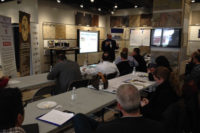In speaking with people at the recent Coverings exhibition in Chicago, IL, the universal sentiment I heard was “We are seeing some good signs. Things are starting to pick up.” This was true of both fabricators and stone suppliers at the event, and even some of the machinery suppliers said that they were pleasantly surprised by the amount of interest they were seeing on the show floor.
This all sounds great, but when are we going to see things actually pick up in terms of activity? When are shops going to work to capacity? Better yet, when will they be confident enough to begin investing and expanding?
I recently asked this question to some stone fabricators, and their responses were both candid and insightful.
“The answer is really a subjective one based on the market the fabricator was in, what types of liabilities the fabricator carried, and finally what ‘positive signs’ really means,” said Steven Hauser of Circa, Inc. in Taylors, SC. “I have been in some long and detailed discussions with bankers for a few months now, and what I have learned is the following: First, lending will be far more conservative, and equity will need to outweigh debt by a 2-1 ratio, thus with fewer loans being underwritten, it will be a save-and-buy model rather than an increase in production driven model. Second, what was the fabricator doing? If the fabricator’s revenue stream was driven by tract homes and multifamily projects, then the positive signs are yet to come, as the bottom is only being reached now, and inventory levels haven’t been depleted - nor do they look like they will deplete soon. Third, if the fabricator has transitioned to remodel work, and the fabricator has added a few specialties like restoration, cool fireplaces, alternate surfaces, tile splashes, etc., then there are some preliminary results that says consumer patterns are being driven inward. And with more of a DIY path, the fabricator has to compete against mom and pop, who were laid off and now are garage fabricating at a discount. This means a different profit-to-revenue model is in play and also means that the fabricator has to do more work for less money.”
A similar sentiment was related by Dustin Braudway of Cape Fear Marble and Tile, Inc. of Wilmington, NC, although he added that being forced to examine costs has made his company a more efficient operation. “As we all know, the slowdown has effected everyone to some point. It probably does depend upon which market you were in as to how bad your company felt it,” he said. “I know that we have felt the slowdown, but continued to grow through it as well. We have taken the downturn and tried to put a positive spin on it by really focusing on our business and getting back to the basics. I think that sometimes we need a check-up in business to get ourselves out of complacency.”
Braudway’s argument cannot be denied. Even here at Stone World, where we are feeling the slowdown as much as anyone in the stone industry, the measures we have taken to reduce costs and increase efficiency will make us a better magazine over the long term - well after this recession is over.
Also of note, Braudway said that his company has managed to invest in the future, due in part to its ability to process multiple types of work. “We are still moving forward with plans of expansion and acquiring some of the deals on used machines and real estate that are now on the market due to the slowdown,” he said. “Our company is diversified and has many avenues to generate revenue. We have had to trim the fat of course on some overstocked employees. No one likes to lay off employees, especially after you have spent the time and money on training them. But with the slowdown, there naturally has to be some cuts. This has allowed companies to weed out the mediocre employees and keep the “rock stars.” I am sure one day in the near future when the markets are full again and the clouds have passed that we will fill back up on employees and thus the cycle will start again.”
So when will we see an upswing where the industry will see increases across the board? Unfortunately, the answer is no clearer now than it was a month or two ago. But even while “survival” is at the forefront of everyone’s mind these days, it is also critical to be thinking about the future and coming out of this a better, more efficient operation.
When will positive signs = positive results?

